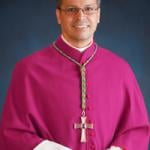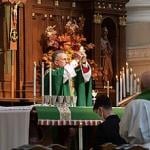Guayaquil, Ecuador, Jul 6, 2015 / 12:11 pm (CNA/EWTN News).- During a Mass said on Monday, the first full day of his visit to Ecuador, Pope Francis called for prayers that the upcoming Synod on the Family might discern the needs of the family, an institution irreplaceable to society. “The Church will celebrate the Ordinary Synod devoted to the family, deepen her spiritual discernment and consider concrete solutions to the many difficult and significant challenges facing families in our time,” the Pope said during his July 6 homily. “I ask you to pray fervently for this intention, so that Christ can take even what might seem to us impure, scandalous or threatening, and turn it – by making it part of his 'hour' – into a miracle.” The family “cannot be replaced by other institutions,” he added. For this reason, “it needs to be helped and strengthened, lest we lose our proper sense of the services which society as a whole provides.” The Mass with the Holy Father was celebrated in Ecuador's Los Samanes Park in Guayaquil, the country's largest city, with 1 million people in attendance, according to estimates. Ecuador is the first stop in Pope Francis’ visit to the continent of his birth, which is taking place July 5-13. The journey will also include stops in Bolivia and Paraguay. In his homily, the Pope reminded the faithful that the family is a small “domestic Church.” “When we experience the love of our parents, we feel the closeness of God’s love,” the Roman Pontiff said. “In our own families and in the greater family to which we all belong, nothing is thrown away, nothing is useless.” Pope Francis centered his remarks on St. John's Gospel account of the wedding at Cana, which was read during the Mass. The scene recounts Mary telling Christ that their hosts have run out of wine, to which he responds that it is not yet “his hour” – a reference to his forthcoming Passion. “Mary’s maternal concern is seen in her plea to Jesus,” the Pope said. “The wedding at Cana is repeated in every generation, in every family, in every one of us and our efforts to let our hearts find rest in strong, fruitful and joyful love.” Pope Francis invited the faithful to “journey with (Mary) to Cana” by following her example as shown in this scene, first by reflecting on her attentiveness to the needs of others. During the wedding scene, Mary notices that her hosts have run out of wine which, the Pope said, “is a sign of happiness, love and plenty.” He compared the Gospel passage to those within families who have run out of this “wine” – people who feel unloved or neglected, or who suffer difficulties such as unemployment or illness. “How many elderly people feel left out of family celebrations, cast aside and longing each day for a little love?” he said. In contrast, through her attentiveness and concern, Mary demonstrates her maternal nature toward others, Pope Francis said. “Mary is not a 'demanding' mother, a mother-in-law who revels in our lack of experience, our mistakes and the things we forget to do,” the Pope said. “Mary is a Mother! She is there, attentive and concerned.” Pope Francis then reflected on the example of confidence with which Mary approached Christ at the wedding feast. “Mary prays. She does not go to the steward, she immediately tells her Son of the newlyweds’ problem.” She receives the seemingly disheartening response from Christ, who says: “What does it have to do with you and me? My hour has not yet come.” Despite this reply, the Gospel recounts how Mary tells the servants to do as Christ tells them, bringing him large jugs of water which he changes into wine. In this scene, Mary “places the problem in God’s hands,” the Pope said. “Her concern to meet the needs of others hastens Jesus’ hour. Mary was a part of that hour, from the cradle to the cross.” “She accepted us as her sons and daughters when the sword pierced her heart. She teaches us to put our families in God’s hands, to pray, to kindle the hope which shows us that our concerns are also God’s concerns.” Having reflected on Mary's example of prayer in Cana, Pope Francis spoke of the role of prayer within the family. “The family is a school where prayer also reminds us that we are not isolated individuals; we are one and we have a neighbour close at hand: he or she is living under the same roof, is a part of our life, and is in need.” Finally, Pope Francis observed how Mary acts, demonstrating how service, which is “the sign of true love,” is learned within the family. In telling the servants to “do whatever he tells you,” Mary is giving “an invitation to us to open our hearts to Jesus, who came to serve and not to be served,” the Pope said. “We learn this especially in the family, where we become servants out of love for one another. In the heart of the family, no one is rejected.” “The family is the nearest hospital, the first school for the young, the best home for the elderly.” Pope Francis concluded by turning back to the narrative of the wedding at Cana, and how, thanks to Mary, everyone could enjoy the “finest of wines,” especially those without hope. “The time is coming when we will taste love daily, when our children will come to appreciate the home we share, and our elderly will be present each day in the joys of life,” the Pope said. “The best wine is yet to come for those who today feel hopelessly lost … whisper it to the hopeless and the loveless. God always seek out the peripheries, those who have run out of wine, those who drink only of discouragement.” Read more















